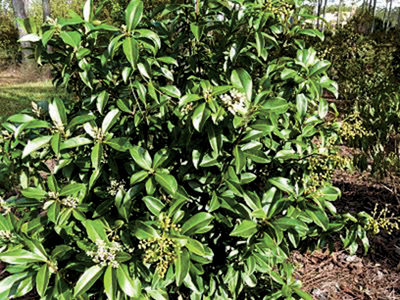The marlberry (Ardisia escalloniodes) plants are native to Central and Southern Florida as well as the Caribbean, Mexico and Central America. It starts out in a bush form but can reach a maximum height of about 20 feet tall. On Sanibel you will typically find its height in the 12 to 15 foot tall range with very little care. Its glossy leaves and grayish-white bark give it that fresh and vibrant appearance.
The native plant puts out clusters of small white flowers, a sweet fragrance and small berries. The berries start out with a white to pale green color and then darken to a deep purple color that attracts a wide variety of birds and fauna. With the dense sometimes weeping arches of the berries and clustering of the leaves it provides perfect cover for the small birds and animals. It is also rumored that the Seminole indians would use the marlberry plants for making their arrows, skewers to roast meat and they would use the leaves as an ‘extender’ for their smoking tobacco.
You will commonly find it in the coastal ridges and hammock areas of Sanibel that mainly consist of moist soils and in thickets of cabbage palms, stoppers, beautyberry and wild coffee plantings. It will tolerate those deeper shady areas, but will grow faster and produce more flowers and berries with increased light. Peak season for flowers and berries is in fall, however, they do cycle throughout the year and there is a good chance that at least a few different plants will be blooming while the others are starting the new cycle giving interest to different areas of your garden. The marlberry makes for an interesting native plant in the island native landscape.
This plant column is a joint effort by all at In The Garden, a Sanibel garden center located at 3889 Sanibel Captiva Road, Sanibel, Florida.
